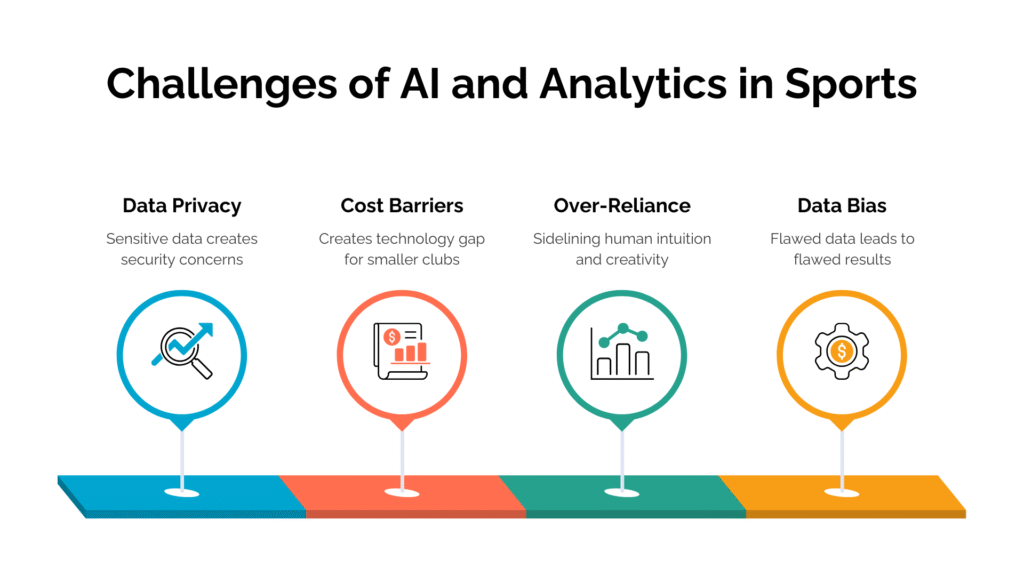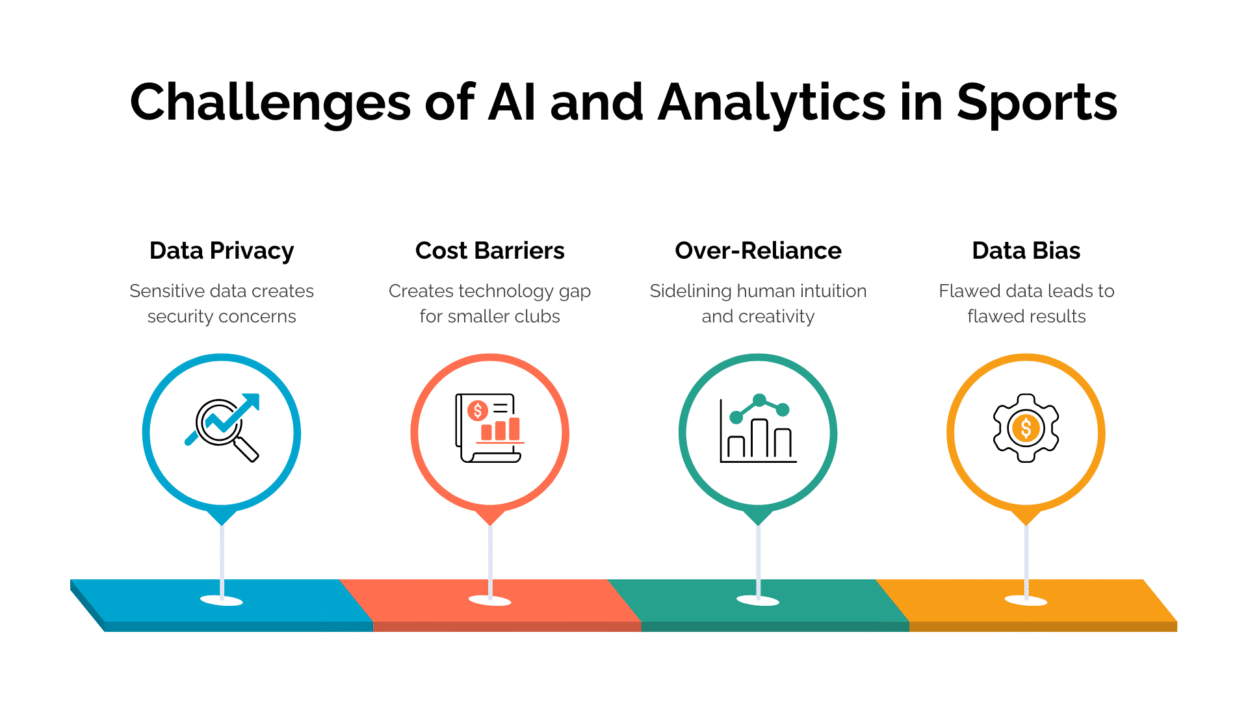Sports have always been about talent, hard work, and strategy. But in today’s world, performance is no longer measured only by what coaches see on the field—it’s measured by data. The rise of Artificial Intelligence (AI) and data analytics is fundamentally transforming how athletes train, how teams strategize, and how fans experience sports.
The use of AI and analytics in sports has become mainstream, shifting from experimental tools to essential performance drivers. From predicting injuries to fine-tuning strategies in real time, these technologies are reshaping the entire sports ecosystem.
This article explores the key ways AI and data analytics are revolutionizing sports performance, the industries leading the charge, and what the future looks like.
1. The Rise of Data-Driven Sports
Traditionally, coaches relied on observation, intuition, and experience to make decisions. While effective, this approach left room for bias and overlooked patterns hidden in performance data.
Today, AI and analytics allow teams to analyze thousands of data points—from player movement and biometrics to opponent tendencies. The result? Objective, data-driven insights that enhance decision-making.
For example:
- In football (soccer), player-tracking systems measure sprint speed, distance covered, and positioning.
- In basketball, AI breaks down shot accuracy by court zones and defensive pressure.
- In cricket, analytics predict bowlers’ strategies and recommend batting responses.
2. AI in Athlete Training and Performance Optimization
AI-powered tools are helping athletes push boundaries while minimizing risks.
- Personalized Training Programs: AI tailors workouts based on individual strengths, weaknesses, and recovery needs. No two athletes follow the same regimen anymore.
- Biomechanics Analysis: Motion-capture cameras and AI detect flaws in movement, helping refine techniques such as a tennis serve or a golf swing.
- Injury Prevention: By analyzing wearables and biometric data, AI predicts fatigue levels and identifies when an athlete is at risk of overtraining or injury.
3. Wearable Tech + AI = Real-Time Insights
The global sports wearable market is booming, with devices like smartwatches, GPS trackers, and biosensors becoming standard.
AI takes this data and provides real-time feedback:
- Heart rate and oxygen levels are tracked to optimize endurance.
- Muscle load sensors help athletes balance intensity and recovery.
- Hydration and sleep patterns are monitored for peak readiness.
4. Data Analytics in Game Strategy
Beyond training, analytics is transforming in-game strategy. Coaches and analysts use predictive models to guide decisions during matches:
- Opponent Analysis: AI studies past games to identify patterns, such as how a basketball player reacts under defensive pressure.
- Tactical Adjustments: In football, real-time tracking helps coaches reposition players to counter opponent formations.
- Simulation Models: Teams simulate different game scenarios and predict outcomes before making key decisions.
5. AI in Scouting and Recruitment
Finding talent is no longer limited to scouts watching matches. AI algorithms now analyze performance data from thousands of players worldwide.
- Performance Metrics: Instead of relying on a player’s highlight reel, AI looks at consistency, stamina, and improvement trends.
- Potential Prediction: Analytics can identify young athletes with high growth potential before they become stars.
- Reducing Bias: AI recruitment tools aim to minimize human bias, ensuring diverse and merit-based selections.
6. Injury Prevention and Rehabilitation
One of the biggest threats to an athlete’s career is injury. AI and data analytics are helping address this through:
- Predictive Analytics: By monitoring physical stress and biomechanical patterns, AI predicts when an athlete is at risk.
- Customized Recovery: Rehabilitation programs are tailored to individual recovery speed, reducing downtime.
- Virtual Physical Therapy: AI-powered tools guide athletes through safe, at-home rehabilitation exercises.
7. Fan Experience and Engagement
AI and data analytics aren’t just transforming athletes—they’re revolutionizing the fan experience too.
- Enhanced Viewing: Real-time stats and predictive insights appear on screens, making games more interactive.
- Fantasy Sports & Betting: AI-driven predictions make fantasy leagues and betting platforms more engaging.
- Personalized Content: Fans receive tailored highlights, replays, and merchandise recommendations.
8. Industries Leading the Way
Several sports have become pioneers in AI and analytics adoption:
- Football (Soccer): Clubs like Manchester City and FC Barcelona use AI for performance tracking and opponent analysis.
- Basketball: The NBA leverages player-tracking systems to enhance both performance and fan engagement.
- Tennis: Hawk-Eye AI systems provide line-call accuracy and player movement insights.
- Baseball: The MLB has embraced analytics for pitching, batting, and player recruitment.
- Cricket: AI-driven insights are used in broadcasting, player training, and injury management.
9. Challenges of AI and Analytics in Sports

Despite the benefits, adoption comes with hurdles:
Data Privacy
The collection of sensitive biometric and health data raises serious privacy and security concerns. Clubs must ensure strict compliance with data protection regulations to maintain athlete trust.
Over-Reliance on Technology
Too much dependence on AI risks sidelining human intuition, creativity, and game-time instinct.
A balance between data-driven insights and human decision-making is essential.
Cost Barriers
Advanced AI and analytics systems require heavy investments, which small clubs may not afford. This creates a technology gap, giving wealthier organizations a competitive edge.
Bias in Data
AI systems are only as good as the data they’re trained on—biased data leads to flawed results.
Clubs must prioritize high-quality, diverse datasets to avoid misleading insights.
10. The Future of AI and Analytics in Sports
Looking ahead, the combination of AI, wearables, and immersive technologies will create hyper-personalized, data-rich sports ecosystems.
- Metaverse Integration: Fans may soon experience live games through VR with real-time analytics overlays.
- AI Coaches: Virtual assistants could supplement human coaches with instant tactical insights.
- Full Integration: Every athlete’s journey—from training to recovery—will be mapped, predicted, and optimized by AI.
Final Thoughts
AI and data analytics are not replacing talent or coaching—they’re amplifying them. From optimizing training and preventing injuries to transforming recruitment and enhancing fan experiences, these technologies are making sports more precise, engaging, and future-ready.
For athletes, it means longer, healthier careers. For teams, it means smarter investments and strategies. And for fans, it means deeper, more immersive connections to the games they love.
In the end, the winners of tomorrow’s sports world won’t just be the fastest or strongest—they’ll be the ones who embrace the power of data and AI.



